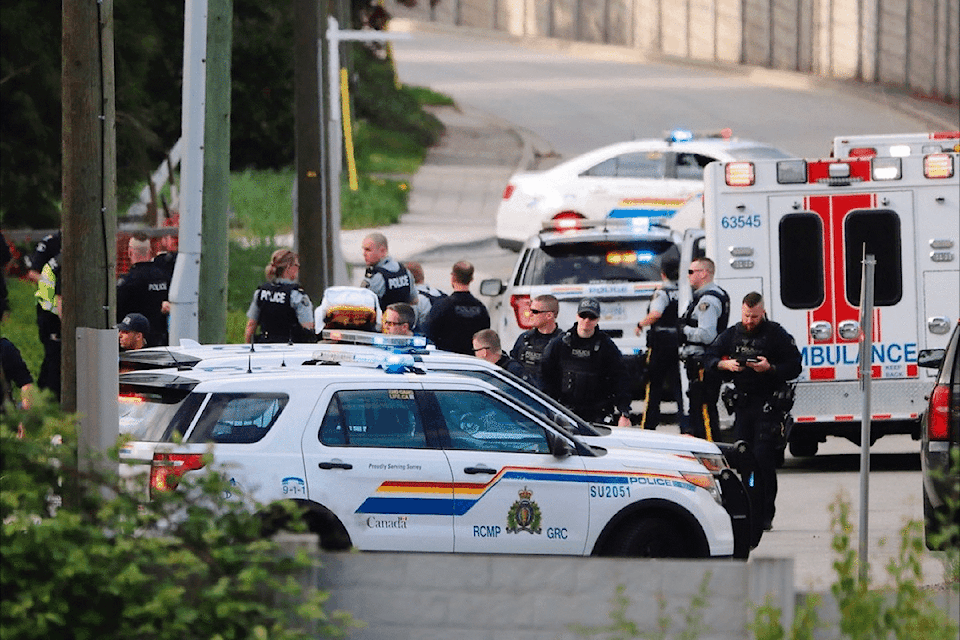Surrey’s crime rate dropped in 2018 for the fourth consecutive year, according to data released by Statistics Canada in late July.
The city’s Crime Severity Index (CSI) dropped 8.86 per cent in 2018 compared to the year prior, from a score of 98.2 to 89.5.
The CSI is a national measure of police-reported crime. Unlike the traditional crime rate, which only counts the number of crimes in a jurisdiction, the CSI is a comprehensive measure that takes into account the seriousness of crime — a higher score indicates a greater number and/or greater severity of crimes, and a low CSI rate generally indicates that a community is relatively safe.
In all, Stats Can data indicates there were 43,541 Criminal Code violations in Surrey last year, down from 45,010 in 2017, 48,765 in 2016, 51,116 in 2015 and 51,406 in 2014.
Of the 2018 incidents, 5,946 were violent crimes.
“Statistically, you’re more safe than you were four years ago,” Surrey RCMP Corporal Elenore Sturko said of the recently released data. “Crime is going down, but we can’t discount people’s perception.”
“So we continue to do things like community outreach, talking about the statistics, answering peoples’ questions about the service we’re providing because we want to make sure we address their perceptions of crime, and feelings of safety in the community,” Sturko added. “Our number of shootings is actually down at this point, year-to-date (compared to 2018), but we’re talking about things that have a community impact.”
As of Aug. 2, there had been 23 reports of shots fired in Surrey so far this year, which police say is a 21 per cent decrease from this time in 2018. There were 38 shootings in Surrey in 2018, and 59 in 2017. In 2016 there were 61 and in 2015 there were 88.
“It wouldn’t be a surprise to us that individuals in the community feel unsafe with this type of incident happening because they have a huge impact,” said Sturko.
“People see things like collisions daily and while impactful on the community and big impacts with injuries or loss of life, there’s quite a bit of trauma for the community in events like shootings. It has a large impact on people’s fear of victimization and crime.
“Statistics are on one side, then there’s that human side where regardless of what the statistics might tell us - crime going down - if people are feeling unsafe, we still have work on both sides to do.”
Meantime, the Statistics Canada data reveals the number of Surrey RCMP files deemed “cleared” rose in 2018 compared to the year prior, with 12,302 and 11,103 cases cleared, respectively. Of the 2018 files, 6,619 were considered closed after a charge or charges were approved, and another 5,683 were “otherwise” cleared following other measures, such as diversion or alternative justice programs.
The CSI for violent crimes in Surrey, specifically, fell by 5.27 per cent in 2018 compared to 2017, from a rating of 81.41 to 77.12. This category has also dropped every year since 2014, with the exception of 2015 when there was a 13.34 per cent increase from 2014.
But in all, there were 5,946 violent crimes documented in Surrey last year, up slightly from the 5,819 in 2017, which was a reduction from the 6,348 cases in 2016.
In 2018, homicides in Surrey rose to 15 from 12 in 2017, nine in 2016, eight in 2015. In 2014, the city saw 17.
Sexual assaults, meantime, are broken down into several categories. In 2018, Surrey RCMP saw a slight decline of “level 1” sexual assaults (248), up from 241 in 2017, 151 in 2016. In 2015, there were 260 cases and in 2014, 193. There were another two sexual assault incidents involving a weapon or bodily harm, which was the same as 2017 and 2016. There was one reported case of “aggravated” sexual assault in Surrey last year.
Sex crimes against children, meantime, spiked in Surrey last year, from 137 in 2017 to 161 in 2018. That is up from 107 in 2016, 73 in 2015 and 62 in 2014. The rate per population increased alongside the number of cases, from 24.69 in 2017 to 28.34 in 2018.
Firearms violations, meantime, held steady last year compared to 2017, at 35. That was a drop from 50 in 2016 and 69 in 2015.
Robberies dropped last year, from 386 in 2017 to 312 in 2018. In 2016 there were 516, 763 in 2015 and 737 in 2014.
Break-ins, specifically, also dropped, with 2,751 incidents in 2018, down from 3,309 in 2017 and 4,013 in 2016.
Also on the decline in 2018 were property crime violations, with 26,164 incidents in 2018, down from 29,365 in 2017 and 31,223 in 2016. Vehicle thefts have also dropped, with 2,135 incidents in 2018, down from 3,004 in 2017, 3,089 in 2016 and 3,304 in 2015.
There was a spike in abduction cases in 2018 (seven), up from three in 2017, four in 2016, which had been a drop from 10 in 2015. Impaired driving violations rose in 2018 from the year prior, with 1,229 incidents last year versus 1,059 in 2017. Drug crimes were also up in 2018 (2,478 incidents) from the year prior, which saw 2,214 incidents.
In Delta, overall severity of crime held steady in 2018 compared to 2017 despite a 30 per cent jump in violent incidents in the city. Delta’s overall CSI was 52.68 points in 2018, compared to 52.78 in 2017.
Vancouver’s CSI dropped from 110.53 in 2017 to 108.45 in 2018, and White Rock saw a spike from 69.48 in 2017 to 83.06 in 2018.
The national CSI increased for a fifth straight year in 2018 to sit at 75.01.
-Files from James Smith
